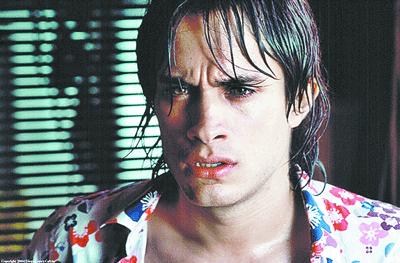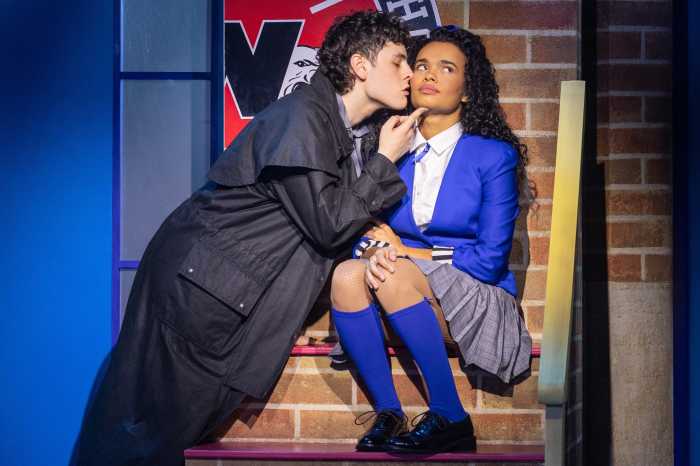Pedro Almodóvar looks back to a Catholic school youth but bogs down in teases and twists
This incredibly tangled narrative really begins with two young boys, Enrique and Ignacio, who fall in love in a Spanish Catholic school, in the repressive Franco-era 1960s. Ignacio is continually harassed by Father Manolo, who is passionately obsessed with the boy. Years later, in 1980, Enrique (Fele Martinez), now a famous movie director––read Almodóvar––looking for film subjects, is visited by Ignacio (Gael Garcia Bernal), now an aspiring actor, with a story, his story, to offer. His screenplay, and the film Enrique decides to make of it, is his revenge against Manolo, who has left the church to marry and raise a family of his own.
Who, really, is Ignacio?
Almodóvar has, by this time, attained a magisterial authority in his directorial technique, and “Bad Education” is marked by a plethora of strikingly cinematic sequences. Unfortunately, the director has allowed his love for the film noir genre to dissipate the overall effect of his work. The plot is as intricately––and, one feels, as unnecessarily twisted––as the most baroque 19th century opera libretto. The Pirandellian shifts of point of view, the filming-within-filming, the actual characters versus the actors playing them all become slightly bewildering and the viewer, initially more than willing to be seduced into taking this ride, becomes increasingly psychologically and emotionally buffeted by it. In the end, one feels more confusion and emotional exhaustion than enlightenment.
The childhood scenes, heavily autobiographical for Almodóvar, have a fraught power and deep empathy, moods that dominate the entire film. One may question Almodóvar’s kitschy setting of new, self-scripted lyrics to the song “Moon River,” which he has the young Ignacio singing for Manolo, but there is no denying the power of the sequence, which has the boy rebuffing the priest’s unseen advances in the bushes. The pervasive sexual dread and brutality of the school’s atmosphere, engendered by the lustful, hypocritical priests, are vividly rendered. Nothing that follows––not the picaresque scenes involving the vengeful transvestite, Zahara (Bernal, again), whom Ignacio has created as an alter ego for his screenplay, and certainly not the sequences dealing with the too-bland Enrique’s creative process and growing seduction by Ignacio––can match the horror of the two boys’ youth. And, with Manolo’s re-entrance, as a family man but still crazy about Ignacio, the film becomes a rather ordinary and predictable genre piece, with typical noir-esque betrayals and expositional baits-and-switches.
Bernal delivers a virtuosic triptych of performances. He is, convincingly, the enthusiastically callow, hungry wannabe actor, ranting about the crap fringe performances he’s been forced to do. Then, as more truth is revealed, he becomes a much smoother sort of hustler, hyper-aware of his own allure and power over the eternally besotted Manolo. And, finally, as Zahara, he makes the most luscious cinematic drag queen since Johnny Depp in “Before Night Falls.” With big hair and a bigger smile, reminiscent of Julia Roberts, the actor has stated that he channeled “the inner transvestite we all have,” and, boy, has it ever worked! Almodóvar here pays full homage to the cross-dressing heritage that marks his entire oeuvre, as well as to divas of the past such as Sara Montiel, whose music he employs with his customary canny seductiveness.
Yet, for all of Bernal’s flashy versatility, there is, somehow, something lacking. What he is playing, really, is an Almodóvar-ized version of the great noir femme fatales of the past, but the actor lacks the subterranean, truly mesmerizing mystery and psychological penetration of Barbara Stanwyck (“Double Indemnity”), Mary Astor (“The Maltese Falcon”), Jane Greer (“Out of the Past”) or Angelica Huston (“The Grifters”).
One critical weakness of the film are the bland performances of too many in the cast. Apart from Javier Càmara who is a raunchy, coke-addled delight as Zahara‘s girlfriend, and Daniel Giménez Cacho, who brings a Velasquez intensity to the movie-within-the movie version of Father Manolo, the other guys in the basically all-male cast are mostly big, literal stiffs.
I assume we are meant to feel a sort of eventual compassion for the tortured, real-life Manolo, but, as insipidly played here by Luis Homar, such is impossible. Fele Martinez comes across as an egotistical blank, no match for the colorful Almodóvar.
Cinematographer José Luis Alcane emerges as a real star of the film, with his gorgeously evocative compositions and Alberto Iglesias‘ music adds further rich texture to this initially fascinating but ultimately enervating film.


































